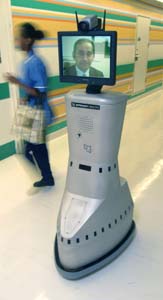Metal medicine
- 2 October 2006
 Joe Fernandez
Joe Fernandez
Robots with artificial intelligence, supporting humans with their day-to-day lives, are common staples of science fiction and cartoons. But they could soon become a reality now that Imperial College, London and St Mary’s Hospital are looking into using remote presence robots to provide support with patient care.
Over the past year James Ballantyne, a clinical research assistant at Imperial College, and research fellow and specialist registrar Parvinderpal Sains have been working with Professor Sir Ara Darzi in exploring the potential of integrating robotics into medicine and surgical care using an American remote-presence robot named RP7.
Ballantyne told EHI: “Robotic technologies are becoming an everyday part of medicine. Robots can be seen helping a surgeon perform the most minute operations on tiny infant hearts. Robots are found in pharmacies dispensing prescriptions.
“Now, robots can even be found wandering the hallways of hospitals helping doctors connect face-to-screen with their patients.”
The robot (right), which is controlled over a wireless LAN, looks like a large vacuum cleaner with a monitor and webcam on the top. The clinician controls the robot and appears to the patient on the monitor using a high-tech ControlStation, where he can film himself whilst observing the patient and control the robot to mimic human head movements.
The ControlStation is a large desk that contains two 15" monitors, and a joystick to control the robot. It also has a webcam to film the clinician and a microphone for them to communicate with the patient, so that they can do the rounds without leaving their chair.
Remote learning
The RP7 has also been used as a teaching tool, with medical students able to see how it works and what to look out for in more detail than you normally would, crowding round a patient.
Ballantyne explained: “We set up a clinical ward with just three beds in it and used the robots to take observation charts and check the intravenous fluids, and after much testing, we found that clinicians were able to get 96% correct observations and 90% correct measurements for intravenous fluids.
“We also used it as a learning tool for trainees doing skin sutures and vascular anastomosis, and they found that it was a much less intrusive way of learning and gave good visualizations of the patient’s condition.”
The webcam can also be used to take pictures of x-ray images, although there will be little need for this with the implementation of PACS and the fact that the screen is only 15”.
Ballantyne said that patients were impressed with the technology and felt that it did not make any difference to their treatment plans.
Colin Jervis, director of Kinetic Consulting and author of the Future Health IT blog, told EHI that he hopes to see the use of Carebots – caring robots- to help provide support to the NHS as the UK’s elderly population grows.
“By 2050 one in four of those living in the UK will be over the age of 65. Many of these will sooner or later require chronic care, placing increased demands on an already stretched NHS.
“To meet this challenge, healthcare and local authority services will need to reconfigure by placing greater emphasis on community care and the effective use of technology – such as robotics.”
Robots vs telehealth
There are several ways that robots can assist the elderly and chronically-ill. They can make up for cognitive decline, for example by reminding patients to take a drink, take medicine or attend appointments. They can also enable patients and caregivers to interact more effectively, collect data and perhaps assist people in domestic chores.
But one could argue, that with the exception of assisting patients, telehealth systems are just as capable of doing a robot’s job.
Jervis disagrees: “With telehealth machines, one does not have the freedom they would have with a robot. They are monitored 24/7 while a robot would be on hand when it is needed, and not all the time.”
Jervis sites Japan as an example of ‘carebots’ providing support to the elderly. Japan’s population is the most rapidly ageing in the world: 30 million people (25% of the population) are over 65. Technology has gone a long way there, with robots being used in healthcare and delivering the benefits proposed for the UK.
For instance, there is a robot doll called Primo Puel, which talks, giggles and asks for cuddles – a cute way to monitor patients’ vital statistics and communicate them to carers.
Mitsubishi has developed the Wakamaru robot, which stands at 1m tall and speaks to patients. It can walk and run, and understands 10,000 words. The robot moves around on wheels and guards the house, monitoring the patient at regular times. When not needed, it re-charges its own batteries itself.
Rivals Honda have unveiled the ASIMO robot, which stands at 1.3m tall and uses sensors and a camera to ensure everything is alright. It will help patients with mobility problems walk and will bring medication and meals to the patient.
Jervis says that patients there have enjoyed the company of the robots there and they say the robots help them with their social skills, avoiding feelings of loneliness and isolation.
He added: “Humans compare unfavorably with robots, tiring easily, taking longer to train, needing special fuel, being expensive to maintain, becoming easily bored by repetitive tasks—and—you just cannot get the spare parts for them.”
Pros and cons of robots in health
Pro: Makes checking on patients easier
Con: Patients prefer the personal approach.
Can help ensure medicine compliance
Some would argue that is what carers are paid for.
Provides support to patients
Buying a robot is very expensive; it would be cheaper to hire a carer.
Can move around to all the patients and get instant diagnosis
At a speed of 1.8mph, it might be quicker for clinicians to do the walk round themselves.
Can provide images for clinicians to examine and draw on
The implantation of PACS is already doing this work.
Monitors patients, ensuring no healthcare emergencies
Telehealth products can do the same thing, for a much cheaper price.
Can provide images from anywhere where there is a ControlStation
Walking route is restricted. The robot cannot call lifts or walk stairs to see a patient on a different ward.
Can store patient records in memory
What if the robot is stolen? Will others be able to see confidential patient data?
Will help ensure best care possible for the patient
Preconceptions of robots from movies could lead to fear from patients of malfunctions.
Easily rechargeable
What happens if the robot’s battery fails mid-diagnosis?
Is available all the time
Are all clinicians going to be trained to use the robot?
Easy to use using Windows XP and wireless communication
What happens if the PC system crashes or the network goes down?




